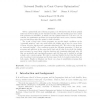Free Online Productivity Tools
i2Speak
i2Symbol
i2OCR
iTex2Img
iWeb2Print
iWeb2Shot
i2Type
iPdf2Split
iPdf2Merge
i2Bopomofo
i2Arabic
i2Style
i2Image
i2PDF
iLatex2Rtf
Sci2ools
MP
2007
2007
Universal duality in conic convex optimization
Given a primal-dual pair of linear programs, it is well known that if their optimal values are viewed as lying on the extended real line, then the duality gap is zero, unless both problems are infeasible, in which case the optimal values are +∞ and −∞. In contrast, for optimization problems over nonpolyhedral convex cones, a nonzero duality gap can exist when either the primal or dual is feasible. For a pair of dual conic convex programs, we provide simple conditions on the “constraint matrices” and cone under which the duality gap is zero for every choice of linear objective function and constraint right-hand side. We refer to this property as “universal duality”. Our conditions possess the following properties: (i) they are necessary and sufficient, in the sense that if (and only if) they do not hold, the duality gap is nonzero for some linear objective function and constraint right-hand side; (ii) they are metrically and topologically generic; and (iii) they can be ve...
| Added | 27 Dec 2010 |
| Updated | 27 Dec 2010 |
| Type | Journal |
| Year | 2007 |
| Where | MP |
| Authors | Simon P. Schurr, André L. Tits, Dianne P. O'Leary |
Comments (0)

